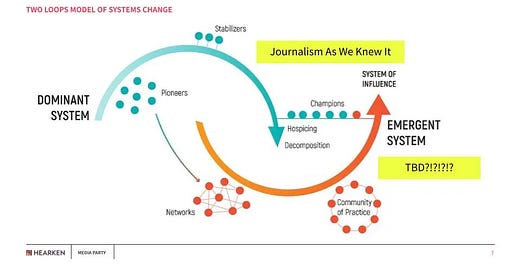Journalism at a Crossroads: Complicating the Narrative, Regenerating Democracy
Toward a Civic Media Ecosystem That Listens, Belongs, and Builds
“There’s a need to not just save journalism but to reconnect it to its democratic purpose.”
— Shia Levitt, News Ambassadors / Bridge Alliance
Across the Thriving Together ecosystem, many of us are sensing the same thing: the dominant media system—driven by polarization, sensationalism, and disconnection—is no longer working. At our May 5 Thriving Together US Nexus Forum, journalist and trainer Shia Levitt named what many were feeling: we need journalism that listens before it speaks.
Shia’s vision reflects an emerging shift in the field—away from journalism as passive reflection, and toward journalism as civic infrastructure: something that can strengthen democracy, restore trust, and build community power from the ground up.
🌀 From “Journalism As We Knew It” to a Civic Media Ecosystem
The image above—shared by Hearken—uses the “Two Loops” model of systems change to illustrate what’s happening. Originally developed by Margaret Wheatley and Deborah Frieze of the Berkana Institute and authors of “Using Emergence to Take Social Innovation to Scale,” this model reflects a deeper truth about how life changes: not through top-down mandates, but through networks, communities of practice, and emergent systems built on trust and shared purpose.
In this frame:
“Journalism as we knew it” sits at the top of the loop—widely consumed but deeply distrusted.
Meanwhile, new players are “hospicing” the old system while cultivating an emergent model grounded in participation, listening, and local trust.
As Shia put it:
“We’re asking communities what they need before prioritizing what to cover—instead of assuming we know what matters.”
This isn’t just a content strategy. It’s a deeper shift toward journalism as shared civic practice.
Learn about Hearken's work with democracy here.
✨ Complicating the Narrative: Journalism That Builds Belonging
A key tool in this new media ecosystem is a deceptively simple idea: complicate the narrative.
This phrase, coined by journalist and author Amanda Ripley author of High Conflict: Why We Get Trapped and How We Get Out, is now a core strategy in the field of solutions journalism and conflict transformation. “Her 2018 essay lays out practices journalists can use to deepen empathy, reveal moral complexity, and surface questions that open hearts instead of hardening positions.
“When people encounter complexity, they become more curious and less closed off to new information. They listen, in other words.”
— Amanda Ripley
At the heart of this strategy are five powerful steps that help transform how we tell stories in times of division:
🔧 Five Ways to Complicate the Narrative
Amplify Contradictions
Highlight nuance and contradiction in people's views—not to discredit them, but to reveal complexity. Let people contain multitudes.Widen the Lens
Connect individual stories to broader systemic dynamics. Zoom out to show patterns, context, and root causes—not just symptoms.Ask Questions That Reveal Motivation
Move beyond “gotcha” or binary framing. Ask: What’s at stake for you? What’s the question no one is asking?Listen More (and Better)
Practice "looping for understanding"—mirroring back what people say to confirm you’ve truly heard them. It builds trust and opens space.Expose People to the ‘Other Tribe’ — Thoughtfully
Facilitate exposure to differing views in non-threatening ways—through stories, dialogue, or convenings—with emotional safety and shared purpose.
These practices are now being used in newsrooms, community dialogue initiatives, and media trainings across the country. They’re also part of the DNA of initiatives like News Ambassadors, Hearken, and Spaceship Media.
Read Ripley's “22 Questions that ‘Complicate the Narrative’” here.
🔍 Highlighting the Innovators: Pioneers of the Emergent System
A few of the efforts leading this shift include:
🔸 News Ambassadors
Training young journalists in community listening, depolarization, and belonging-centered reporting.
🔸 Hearken
Helping newsrooms practice “public-powered journalism,” where community members guide coverage through questions and story co-creation.
🔸 Spaceship Media
Facilitating deep dialogue through media partnerships, helping audiences and reporters alike get underneath the story.
As Doug Oplinger reflected in the Forum, we are in a moment of “cross-reality tension.” Our media systems too often reflect that divide rather than help us navigate it.
“Forever, we have looked to journalism in America as something to shoot for... the way to help our countries be democracies. In the last three months, that’s all disappeared. We no longer have a role model.”
— Doug Oplinger, Your Voice Ohio
🧱 Journalism as Civic Infrastructure
The Thriving Together framework invites us to think of civic health as a system of Vital Conditions. Among them is Belonging and Civic Muscle—the capacity of people to shape their communities and feel seen doing it.
That is where journalism comes in. When media centers community stories, when it listens before speaking, when it helps people see each other more fully, it becomes part of the infrastructure that allows democracy to thrive.
We don’t just need to save journalism. We need to regenerate it.
📣 Read, Share, Join Us
We’re exploring this work more deeply across the Inter-Movement Impact Project. Join us:
🔗 Join Generate Democracy! on LinkedIn
📰 Follow Thriving Together US on Substack
📖 Read Amanda Ripley’s “Complicating the Narratives”
🌍 Learn about the Vital Conditions and Thriving Framework
What stories, experiments, or models are you seeing in your community? Share below or tag a civic journalist who’s helping us see more clearly.
#SolutionsJournalism #CivicHealth #Belonging #ComplicatingTheNarrative #Journalism #Democracy #BridgeBlockBuild #IMIP #ThrivingTogetherUS #NewsAmbassadors #Hearken #PublicTrust #TwoLoops





We need to build and scale an online platform that convenes the audience and actively fosters consensus for action on solutions to our common problems. Let's meet in The Big Middle, where most Americans are.